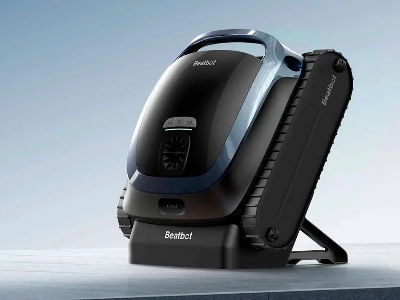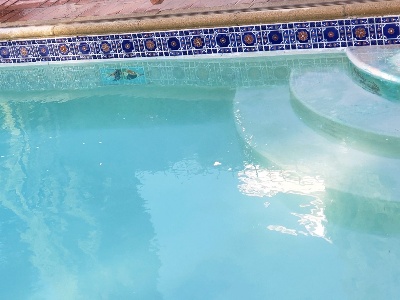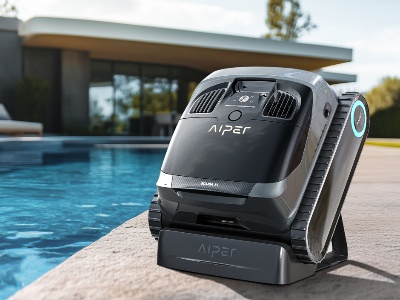The wired pool cleaner is still a widely used piece of equipment in many homes. And for good reason: for a long time it was the only one on the market, and it provided a thorough cleaning of the pool with often acclaimed efficiency. However, in use, many owners become disillusioned. Between tangled cables, insufficient length, chronic knots or simply being an eyesore, the cable often becomes a hindrance rather than a help. In this article, we address the problems of wired robots head-on, while presenting existing solutions to get around these limitations. Because between time savings and ease of use, alternatives do indeed exist.
Solid technical performance but room for improvement in terms of use
On paper, the wired pool robot has it all. Continuously powered via an external electrical socket, it ensures constant power, extended cleaning cycles and the ability to treat large pools with formidable precision. Brands such as Dolphin Maytronics, Zodiac and Hayward offer models capable of effectively cleaning the bottom, walls and waterline. However, these performances are affected by the constraint of the cord: the daily management of the cable quickly becomes a burden. It is necessary to constantly check that it does not become twisted, that it does not obstruct the passage of the robot, or that it does not float on the surface to the point of getting caught in nozzles or steps. The result is an experience often marred by additional handling, when you were expecting a 100% autonomous cleaning.
Coiling, storage and twisted cables
The real hell of the wired robot often begins after cleaning. Once the cycle is finished, the robot has to be taken out of the water... but also a soggy cable, sometimes 12 to 18 metres long, has to be dealt with. The cable is rarely rolled up properly by itself: it forms loops, gets twisted. Some owners invest in a reel or a trolley to limit this inconvenience, but this represents an additional purchase to be planned for. Especially as poorly stored cables end up getting damaged more quickly, cutting or creating false contacts with the power supply. And the more the robot is used, the more the problem increases. Even the 'anti-tangle' systems integrated into some models struggle to completely eliminate this constraint. In use, it is often this factor that pushes many users to look for wireless or more manoeuvrable alternatives. Another point often underestimated with wired robots is the issue of safety. Although manufacturers include low-voltage transformers to power the robot safely, the presence of an electric cable by the pool can be a stress, especially in families with children. It is important to avoid someone tripping over it, the cable remaining submerged for a long time after use, or it being exposed to the sun in hot weather. As a precaution, some users prefer not to use their wired robot cleaner when children are playing in the pool. In addition, for practical reasons, connecting the transformer often requires an extension cord, which is exposed to the elements. At a time when connected devices are becoming wireless for greater convenience, these cables several metres long are starting to look increasingly outdated.
Limited mobility and sometimes incomplete cleaning
The presence of a cable is not only a visual nuisance: it sometimes limits the robot's mobility. In long pools, with stairs, submerged areas or non-standard shapes, the wired robot can get stuck, turn back before finishing or fail to reach certain areas. Users then have to guide the device manually, unwind a little more cable or restart a new cycle to cover the forgotten corners. This is an operation that goes against the principle of automation. Some very high-end models manage to compensate for this constraint with intelligent sensors and advanced navigation algorithms. But here again, the cable remains a weak point. Conversely, wireless models such as the
BEATBOT AquaSense 2 Pro can move freely, regardless of distance or route. This freedom radically changes the user experience, especially for large pools.
Towards a new generation of wireless robots
In the face of these limitations, the market is evolving rapidly. Wireless robots have made huge progress in recent years, particularly in terms of autonomy, suction power and navigation precision. They run on a lithium-ion battery and have an autonomous filter tank. No need for a plug, cable or constant monitoring. Models such as the
AquaSense 2 Ultra by BEATBOT perfectly embody this new generation, combining performance, connectivity and freedom of movement. They cover the entire pool, from the bottom to the walls, without any trailing or tangled cables. They are so comfortable to use that many users of wired robots now switch to wireless after just one or two seasons of use. It is an investment, certainly, but one that completely transforms the daily maintenance of the pool.
Choose according to your needs and constraints
Should you completely abandon wired robots? Not necessarily. They are still suitable for very large or complex pools, provided you have a good cable management system and are not bothered by its presence. But for the majority of users, wireless models offer unrivalled convenience and simplicity. Before choosing, ask yourself the right questions: what is the shape of your pool? Do you have a utility room nearby? Are you prepared to deal with a cable every other day? Do you want to automate as much as possible? If the answer is yes, go for a wireless robot. And if you want to combine efficiency with complete cleaning, don't forget to add a skimmer robot like the
iSkim Ultra from BEATBOT to keep the surface spotless. Because, deep down, what we're really looking for is a clean swimming pool, without having to struggle with metres of cable every time we use it.
When wireless becomes a daily relief
Wired pool cleaners have long been the benchmark. But today, they are starting to show their limitations, particularly in practical terms. Despite their technical advantages, cables quickly become a daily burden. They get in the way, they get in the way, they get in the way. And it is often the cables that turn a high-performance device into a frustrating experience. Thanks to technological advances, wireless is no longer a pipe dream: it is a viable, efficient and increasingly affordable solution. Models such as those offered by BEATBOT clearly mark the transition towards automated, mobile and pleasant maintenance. At a time when simplicity has become an essential criterion of choice, getting rid of cables means saving time, peace of mind... and pleasure. And that is not a luxury, it has almost become a necessity.







